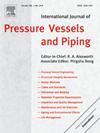Effects of tempering time on microstructure and residual stress of surfacing weldments of thin tube sheets
IF 3.5
2区 工程技术
Q2 ENGINEERING, MECHANICAL
International Journal of Pressure Vessels and Piping
Pub Date : 2025-07-23
DOI:10.1016/j.ijpvp.2025.105611
引用次数: 0
Abstract
Strip electrode electroslag welding was applied to deposit a weld overlay on Q345R thin tube sheets with dimensions of Φ600mm × 20 mm.After welding, four specimens were subjected to heat treatment with varying tempering durations.Post-welding, the matrix microstructure of the EQ309MoL weld overlay consists of austenite and interdendritic ferrite with a dendritic morphology at grain boundaries, while the Q345R base metal near the weld exhibits a microstructure of bainite and acicular ferrite.Following heat treatment, significant carbide precipitation was observed at the austenite grain boundaries in the weld overlay. Moreover, the extent of carbide precipitation increased with prolonged tempering time, and the precipitates were identified as M23C6.The thin tube sheet weldments exhibited the highest residual stress in the as-welded condition, with a magnitude approaching their yield strength (469 MPa). As tempering time increased, the residual stress gradually decreased; after 3 h of tempering, it stabilized at approximately 100 MPa.In the as-welded state, the weldments showed the highest dislocation density, with numerous dislocations accumulating at grain boundaries and within grains. This led to the formation of dislocation tangles and internal strains, resulting in further dislocation accumulation and stress field concentration within grains and near grain boundaries.After tempering, elevated temperatures provided the driving force for dislocation glide, reducing dislocation accumulation and intersections, decreasing dislocation density, and promoting uniform dislocation distribution. This alleviated dislocation accumulation and stress concentration at grain boundaries and within grains, thereby reducing residual stress in the weld overlay.The maximum grain size was 990304 μm2 in the as-welded state, 1122848 μm2 after 1 h of tempering, 1274160 μm2 after 2.5 h, and 1544880 μm2 after 3 h.Grain growth was accompanied by homogenization of grain size distribution, which reduced deformation incompatibility caused by variations in grain size and thus lowered the risk of stress concentration.
回火时间对薄管板堆焊组织和残余应力的影响
在尺寸为Φ600mm × 20 mm的Q345R薄管板上采用条极电渣焊沉积焊层,焊接后对4个试样进行不同回火时间的热处理。焊接后,EQ309MoL焊缝堆焊层的基体组织为奥氏体和枝晶间铁素体,晶界处呈枝晶状;焊缝附近的Q345R母材组织为贝氏体和针状铁素体。热处理后,焊缝覆盖层奥氏体晶界处有明显的碳化物析出。随着回火时间的延长,碳化物析出程度增大,析出相为M23C6。在焊接状态下,薄管板焊缝的残余应力最大,其大小接近其屈服强度(469 MPa)。随着回火时间的增加,残余应力逐渐减小;回火3h后,稳定在100mpa左右。在焊接状态下,焊缝的位错密度最高,晶界处和晶内积聚了大量的位错。这导致位错缠结和内部应变的形成,导致位错进一步积累,晶内和晶界附近应力场集中。回火后,高温为位错滑动提供了动力,减少了位错的积累和相交,降低了位错密度,促进了位错的均匀分布。这减轻了晶界和晶内的位错积累和应力集中,从而减少了焊缝覆盖层中的残余应力。焊态最大晶粒尺寸为990304 μm2,回火1 h后最大晶粒尺寸为1122848 μm2, 2.5 h后最大晶粒尺寸为1274160 μm2, 3 h后最大晶粒尺寸为1544880 μm2。晶粒的生长伴随着晶粒尺寸分布的均匀化,减小了晶粒尺寸变化引起的变形不协调,从而降低了应力集中的风险。
本文章由计算机程序翻译,如有差异,请以英文原文为准。
求助全文
约1分钟内获得全文
求助全文
来源期刊
CiteScore
5.30
自引率
13.30%
发文量
208
审稿时长
17 months
期刊介绍:
Pressure vessel engineering technology is of importance in many branches of industry. This journal publishes the latest research results and related information on all its associated aspects, with particular emphasis on the structural integrity assessment, maintenance and life extension of pressurised process engineering plants.
The anticipated coverage of the International Journal of Pressure Vessels and Piping ranges from simple mass-produced pressure vessels to large custom-built vessels and tanks. Pressure vessels technology is a developing field, and contributions on the following topics will therefore be welcome:
• Pressure vessel engineering
• Structural integrity assessment
• Design methods
• Codes and standards
• Fabrication and welding
• Materials properties requirements
• Inspection and quality management
• Maintenance and life extension
• Ageing and environmental effects
• Life management
Of particular importance are papers covering aspects of significant practical application which could lead to major improvements in economy, reliability and useful life. While most accepted papers represent the results of original applied research, critical reviews of topical interest by world-leading experts will also appear from time to time.
International Journal of Pressure Vessels and Piping is indispensable reading for engineering professionals involved in the energy, petrochemicals, process plant, transport, aerospace and related industries; for manufacturers of pressure vessels and ancillary equipment; and for academics pursuing research in these areas.

 求助内容:
求助内容: 应助结果提醒方式:
应助结果提醒方式:


